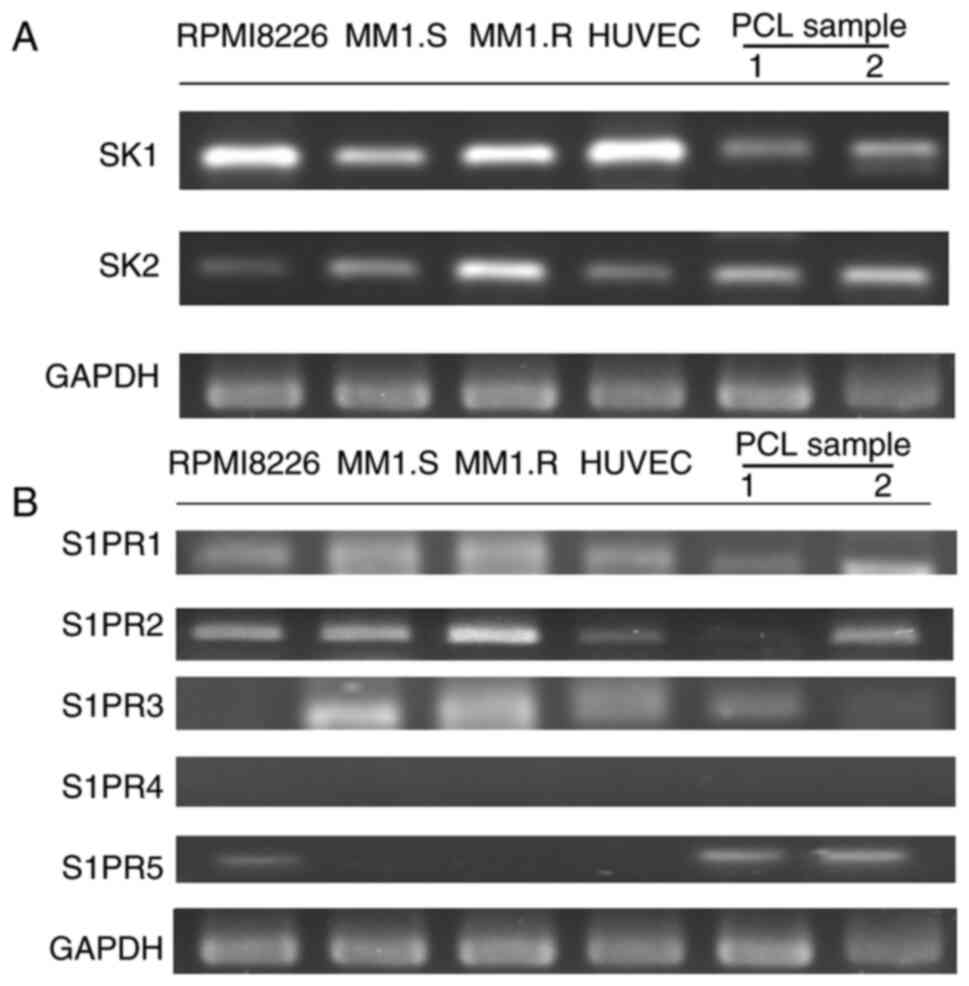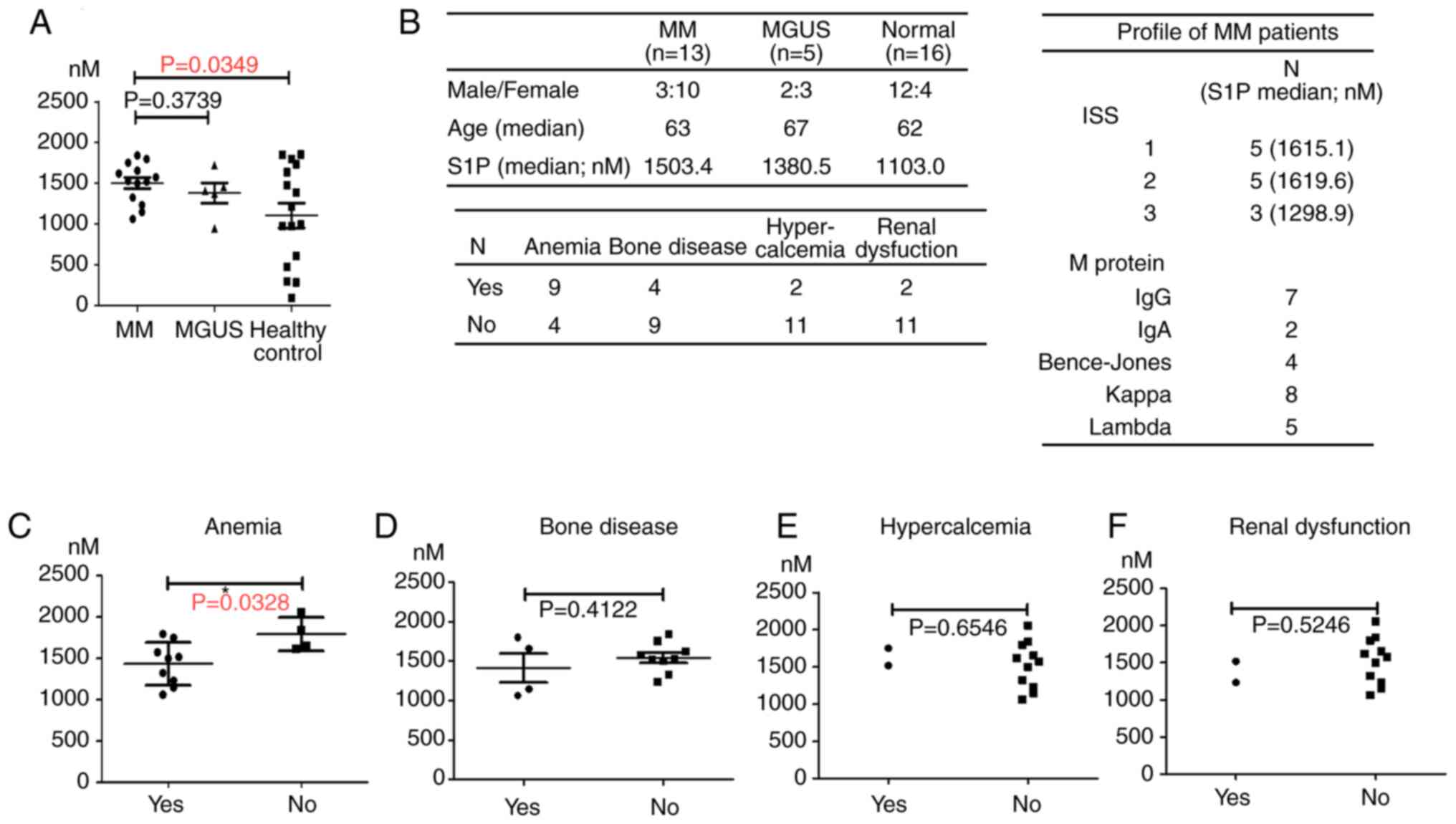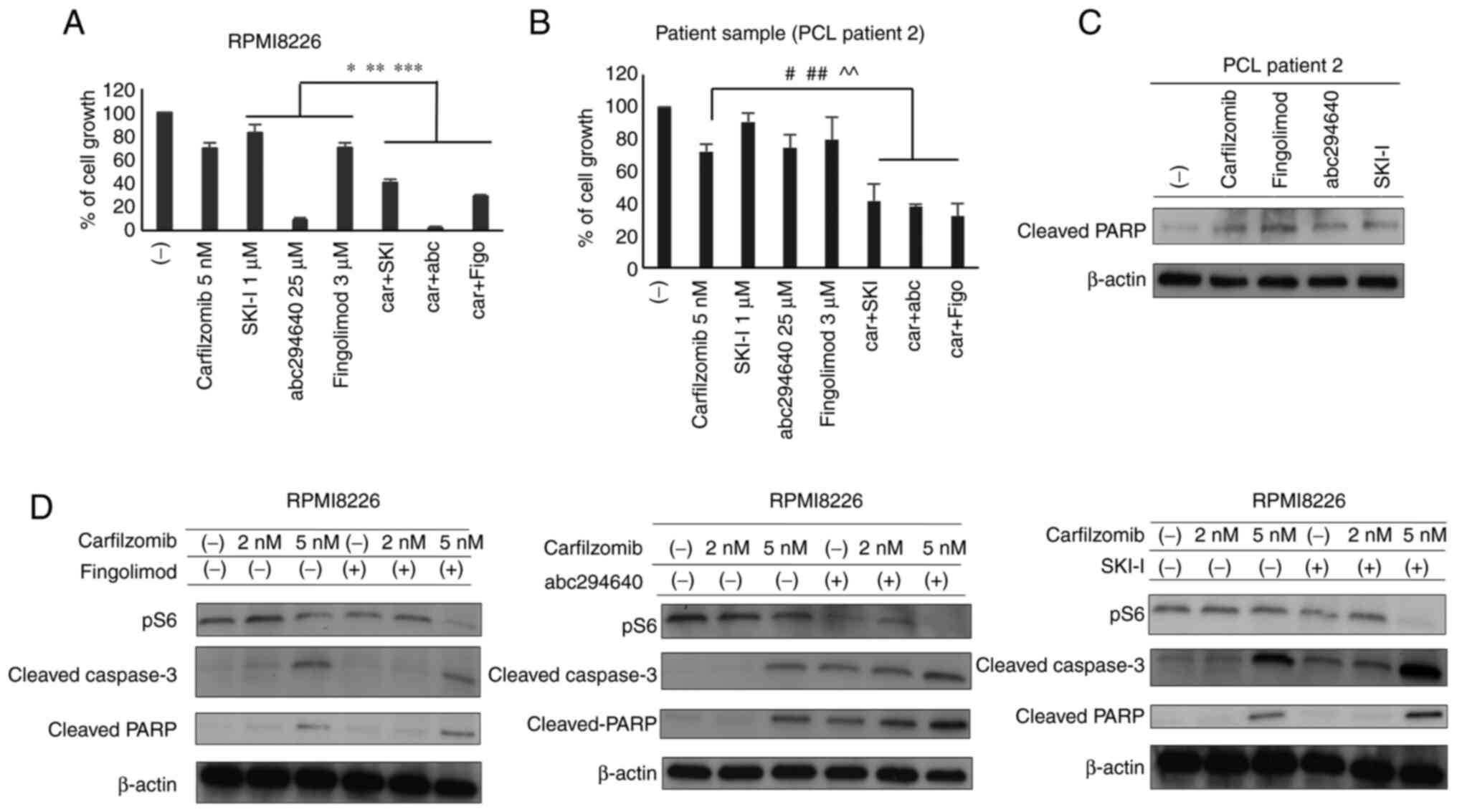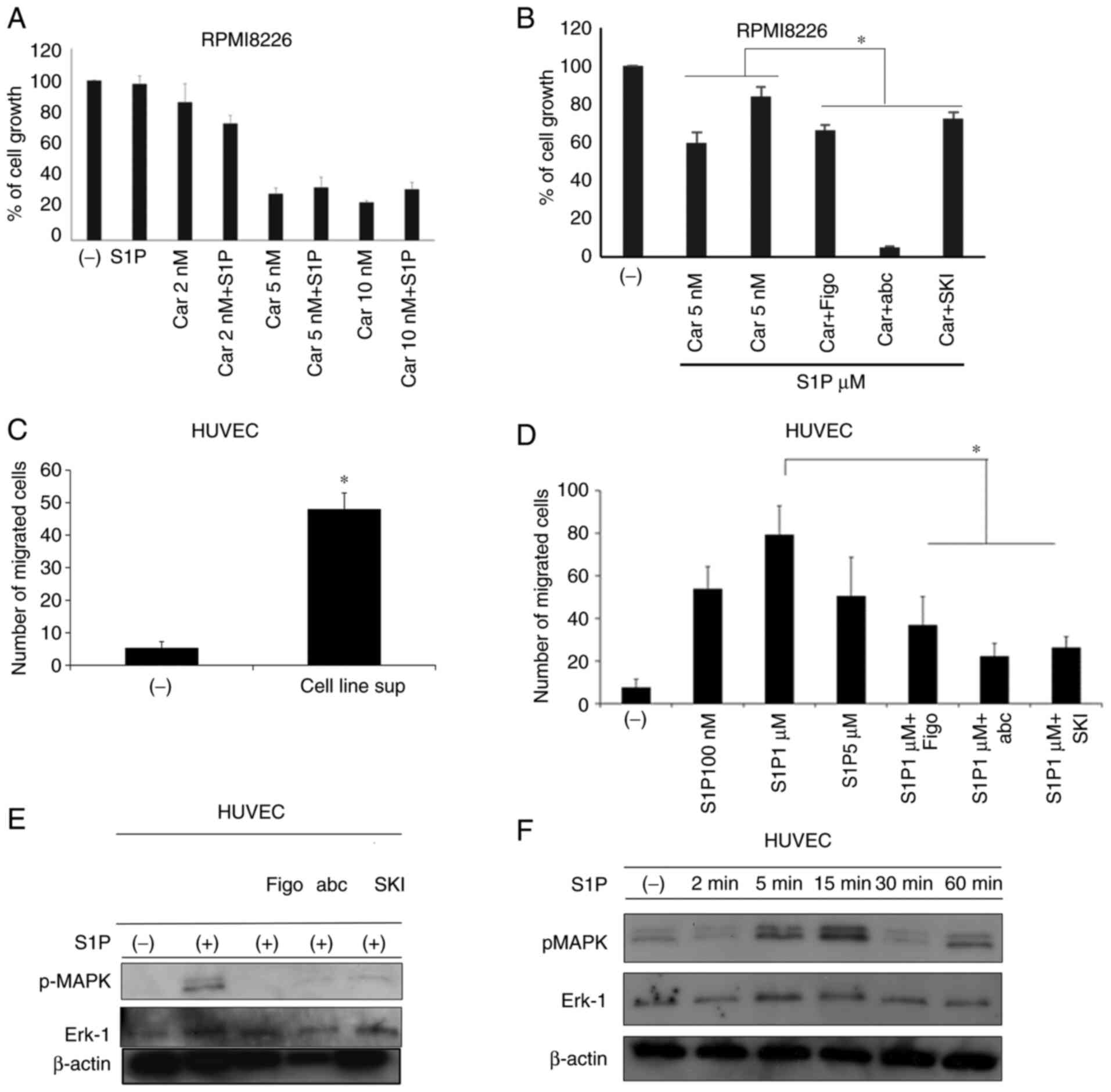|
1
|
Kuehl WM and Bergsagel PL: Molecular
pathogenesis of multiple myeloma and its premalignant precursor. J
Clin Invest. 122:3456–3463. 2012. View
Article : Google Scholar : PubMed/NCBI
|
|
2
|
Kyle RA and Rajkumar SV: An overview of
the progress in the treatment of multiple myeloma. Expert Rev
Hematol. 7:5–7. 2014. View Article : Google Scholar : PubMed/NCBI
|
|
3
|
Nooka AK, Kastritis E, Dimopoulos MA and
Lonial S: Treatment options for relapsed and refractory multiple
myeloma. Blood. 125:3085–3099. 2015. View Article : Google Scholar : PubMed/NCBI
|
|
4
|
Pyne S and Pyne NJ: Sphingosine
1-phosphate signaling in mammalian cells. Biochem J. 349:385–402.
2000. View Article : Google Scholar : PubMed/NCBI
|
|
5
|
Spiegel S and Milstein S: Sphingosine
1-phosphate: An enigmatic signaling lipid. Nat Rev Mol Cell Biol.
4:397–407. 2003. View
Article : Google Scholar : PubMed/NCBI
|
|
6
|
Hannun YA and Obeid LM: Principles of
bioactive lipids signaling: Lessons from sphingolipids. Nat Rev Mol
Biol. 9:139–150. 2008. View
Article : Google Scholar : PubMed/NCBI
|
|
7
|
Pyne NJ, El Buri A, Adams DR and Pyne S:
Sphingosine 1-phosphate and cancer. Adv Biol Regul. 68:97–106.
2008. View Article : Google Scholar : PubMed/NCBI
|
|
8
|
Ogretmen B and Hannun YA: Biologically
active sphingolipids in cancer pathogenesis and treatment. Nat Rev
Cancer. 4:604–616. 2004. View
Article : Google Scholar : PubMed/NCBI
|
|
9
|
Pyne S, Lee SC, Long J and Pyne NJ: Role
of sphingosine kinases and lipid phosphate phosphatases in
regulating spatial sphingosine 1-phosphate signalling in health and
disease. Cell Signal. 21:14–21. 2009. View Article : Google Scholar : PubMed/NCBI
|
|
10
|
Pyne NJ and Pyne S: Sphingosine
1-phosphate and cancer. Nat Rev Cancer. 10:489–503. 2010.
View Article : Google Scholar : PubMed/NCBI
|
|
11
|
LaMontagne K, Littlewood-Evans A, Schnell
C, O'Reilly T, Wyder L, Sanchez T, Probst B, Butler J, Wood A, Liau
G, et al: Antagonist of sphingosine 1-phosphate receptors by FTY720
inhibits anginogenesis and tumor vascularization. Cancer Res.
66:221–231. 2006. View Article : Google Scholar : PubMed/NCBI
|
|
12
|
Paugh SW, Paugh BS, Rahmani M, Kapitonov
D, Almenara JA, Kordula T, Milstien S, Adams JK, Zipkin RE, Grant S
and Spiegel S: A selective sphingosine kinase1 inhibitor integrates
multiple molecular therapeutic targets in human leukemia. Blood.
112:1382–1391. 2008. View Article : Google Scholar : PubMed/NCBI
|
|
13
|
French KJ, Zhuang Y, Maines LW, Gao P,
Wang W, Beljanski V, Upson JJ, Green CL, Keller SN and Smith CD:
Pharmacology and antitumor activity of ABC294640, a selective
inhibitor of sphingosine kinase-2. J Pharm Exp Ther. 333:129–139.
2010. View Article : Google Scholar : PubMed/NCBI
|
|
14
|
Beljanski V, Knaak C and Smith CD: A novel
sphingosine kinase inhibitor induced autophagy in tumor cells. J
Pharm Exp Ther. 333:454–464. 2010. View Article : Google Scholar : PubMed/NCBI
|
|
15
|
Neubauer HA and Pitson SM: Roles,
regulation and inhibitors of sphingosine kinase 2. FEBS J.
280:5317–5336. 2013. View Article : Google Scholar : PubMed/NCBI
|
|
16
|
Xia P, Gamble JR, Wang L, Pitson SM,
Moretti PA, Wattenberg BW, D'Andrea RJ and Vadas MA: An oncogenic
role of sphingosine kinase. Curr Biol. 10:1527–1530. 2000.
View Article : Google Scholar : PubMed/NCBI
|
|
17
|
Akao Y, Banno Y, Nakagawa Y, Hasegawa N,
Kim TJ, Murate T, Igarashi Y and Nozawa Y: High expression of
sphingosine kinase 1 and S1P receptors in chemotherapy-resistant
prostate cancer PC-3 cells and their camptothecin-induced
up-regulation. Biochem Biophys Res Commun. 342:1284–1290. 2006.
View Article : Google Scholar : PubMed/NCBI
|
|
18
|
Okabe S, Tanaka Y, Tauchi T and Ohyashiki
K: Copanlisib, a novel phosphoinositide 3-kinase inhibitor,
combined with carfilzomib inhibits multiple myeloma cell
proliferation. Ann Hematol. 98:723–733. 2019. View Article : Google Scholar : PubMed/NCBI
|
|
19
|
Chen HC: Boyden chamber assay. Methods Mol
Biol. 294:15–22. 2005.PubMed/NCBI
|
|
20
|
Ishii I, Fukushima N, Ye X and Chun J:
Lysophospholipid receptors: Signaling and biology. Annu Rev
Biochem. 73:321–354. 2004. View Article : Google Scholar : PubMed/NCBI
|
|
21
|
Yasui H, Hideshima T, Raje N, Roccaro AM,
Shiraishi N, Kumar S, Hamasaki M, Ishitsuka K, Tai YT, Podar K, et
al: FTY720 induces apoptosis in multiple myeloma cells and
overcomes drug resistance. Cancer Res. 65:7478–7484. 2005.
View Article : Google Scholar : PubMed/NCBI
|
|
22
|
Sanz-Rodríguez F, Hidalgo A and Teixidó J:
Chemokine stromal cell-derived factor-1α modulates VLA-4
integrin-mediated multiple myeloma cell adhesion to
CS-1/fibronectin and VCAM-1. Blood. 97:346–351. 2001. View Article : Google Scholar : PubMed/NCBI
|
|
23
|
Venkata JK, An N, Stuart R, Costa LJ, Cai
H, Coker W, Song JH, Gibbs K, Matson T, Garrett-Mayer E, et al:
Inhibition of sphingosine kinase 2 downregulates the expression of
c-Myc and Mcl-1 and induces apoptosis in multiple myeloma. Blood.
124:1915–1925. 2014. View Article : Google Scholar : PubMed/NCBI
|
|
24
|
Durie BG and Salmon SE: A clinical staging
system for multiple myeloma. Correlation of measured myeloma cell
mass with presenting clinical features, response to treatment, and
survival. Cancer. 36:842–854. 1975. View Article : Google Scholar : PubMed/NCBI
|
|
25
|
Alvarez SE, Harikumar KB, Hait NC,
Allegood J, Strub GM, Kim EY, Maceyka M, Jiang H, Luo C, Kordula T,
et al: Sphingosine-1-phosphate is a missing cofactor for the E3
ubiquitin ligase TRAF2. Nature. 465:1084–1088. 2010. View Article : Google Scholar : PubMed/NCBI
|
|
26
|
Mitroi DN, Deutschmann AU, Raucamp M,
Karunakaran I, Glebov K, Hans M, Walter J, Saba J, Gräler M,
Ehninger D, et al: Sphingosine 1-phosphate lyase ablation disrupts
presynaptic architecture and function via ubiquitin-proteasome
mediated mechanism. Sci Rep. 6:1–15. 2016. View Article : Google Scholar : PubMed/NCBI
|
|
27
|
Wallington-Beddoe CT, Bennett MK, Vandyke
K, Davies L, Zebol JR, Moretti PA, Pitman MR, Hewett DR, Zannettino
AC and Pitson SM: Sphingosine kinase 2 inhibition synergises with
bortezomib to target myeloma by enhancing endoplasmic reticulum
stress. Oncotarget. 8:43602–42616. 2017. View Article : Google Scholar : PubMed/NCBI
|
|
28
|
Banno Y, Takuwa Y, Akao Y, Okamoto H,
Osawa Y, Naganawa T, Nakashima S, Suh PG and Nozawa Y: Involvement
of phospholipase D in sphingosine 1-phosphate-induced activation of
phosphatidylinositol 3-kinase and Akt in Chinese hamster ovary
cells overexpressing EDG3. J Biol Chem. 276:35622–35628. 2001.
View Article : Google Scholar : PubMed/NCBI
|
|
29
|
Ikeda H, Hideshima T, Fulciniti M, Perrone
G, Miura N, Yasui H, Okawa Y, Kiziltepe T, Santo L, Vallet S, et
al: PI3K/p110Δ is a novel therapeutic target in multiple myeloma.
Blood. 116:1460–1468. 2010. View Article : Google Scholar : PubMed/NCBI
|
|
30
|
Kumar S, Fonseca R, Dispenzieri A, Lacy
MQ, Lust JA, Wellik L, Witzig TE, Gertz MA, Kyle RA, Greipp PR and
Rajkumar SV: Prognostic value of angiogenesis in solitary bone
plasmacytoma. Blood. 101:1715–1717. 2003. View Article : Google Scholar : PubMed/NCBI
|



















